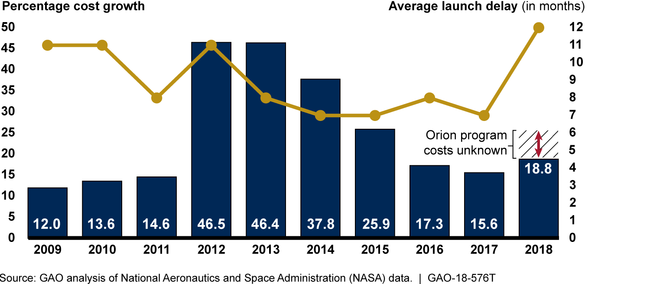NASA Major Projects: Portfolio Is at Risk for Continued Cost Growth and Schedule Delays
Fast Facts
This testimony highlights our 10th annual Quick Look report on the status of NASA's major projects. Many of them experienced significant cost and schedule growth in the past year.
NASA is likely to keep seeing cost and schedule growth because complex new projects are starting up, and other expensive projects are taking longer to launch than expected.
The full extent of cost growth was unknown because NASA didn't have a cost estimate for the Orion crew vehicle, one of its most expensive projects.
The average launch delay was 12 months in this review—the most we've ever reported.
NASA’s Major Project Portfolio Cost and Schedule Performance Deteriorated in 2018

Graphic showing that cost and schedule growth of NASA's major projects has worsened this year with Orion costs unknown
Highlights
What GAO Found
The cost and schedule performance of the National Aeronautics and Space Administration's (NASA) portfolio of major projects has deteriorated, but the extent of cost performance deterioration is unknown. NASA expects cost growth for the Orion crew capsule—one of the largest projects in the portfolio—but does not have a current cost estimate. In addition, the average launch delay for the portfolio was 12 months, the highest delay GAO has reported in its 10 years of assessing major NASA projects (see figure below).
NASA's Major Project Portfolio Cost and Schedule Performance Deteriorated in 2018

The deterioration in portfolio performance was the result of 9 of the 17 projects in development experiencing cost or schedule growth.
- Four projects encountered technical issues that were compounded by risky program management decisions. For example, the Space Launch System and Exploration Ground Systems programs are large-scale, technically complex human spaceflight programs, and NASA managed them to aggressive schedules and with insufficient levels of cost and schedule reserves. This made it more difficult for the programs to operate within their committed baseline cost and schedule estimates.
- Two projects ran into technical challenges that resulted in delays in the integration and test phase. For example, in December 2017, GAO found that the James Webb Space Telescope project encountered delays primarily due to the integration of the various spacecraft elements taking longer than expected, as well as the need to resolve technical issues during testing. GAO has previously found that integration and testing is when projects are most at risk of incurring cost and schedule growth.
- Three projects experienced cost growth or schedule delays due to factors outside of the projects' control, such as delays related to their launch vehicles.
NASA continues to face increased risk of cost and schedule growth in future years due to new, large and complex projects that will enter the portfolio and expensive projects remaining in the portfolio longer than expected.
Why GAO Did This Study
GAO designated NASA's acquisition management as a high-risk area in 1990 after a history of persistent cost growth and schedule slippage in many of NASA's major projects. In more recent years, GAO found that NASA had taken some steps to improve its management, and, in May 2017, GAO found that projects were continuing a generally positive trend of limiting cost and schedule growth. But at the same time, GAO noted that many of these projects, including some of the most expensive ones, were approaching the phase in their life cycles when cost and schedule growth is most likely.
This statement summarizes GAO's 2018 findings from its 10th annual snapshot of how well NASA is planning and executing its major acquisition projects, and describes (1) the cost and schedule performance of NASA's portfolio of major projects and (2) the extent to which NASA faces risks for further cost increases and schedule delays. To conduct its review for the 2018 report, GAO-18-280SP , GAO analyzed cost, schedule, and other data for NASA's 26 major projects, each with a life-cycle cost of over $250 million; reviewed monthly project status reports; and interviewed NASA officials.
Recommendations
GAO is not making any new recommendations in this statement. GAO has made recommendations in prior reports to strengthen NASA's acquisition management of its major projects. NASA generally agreed with these recommendations, but has not fully addressed some of them. GAO continues to believe they should be fully addressed.
